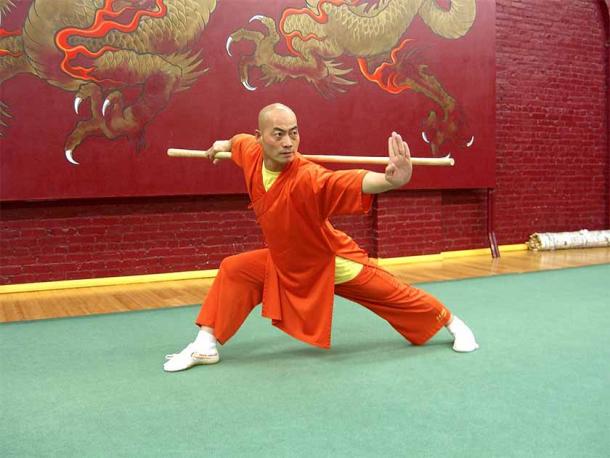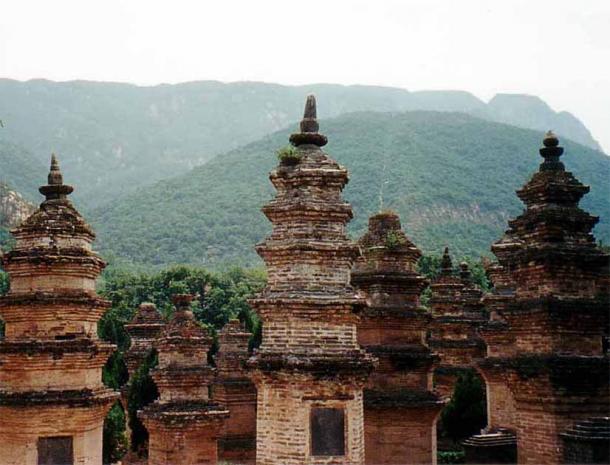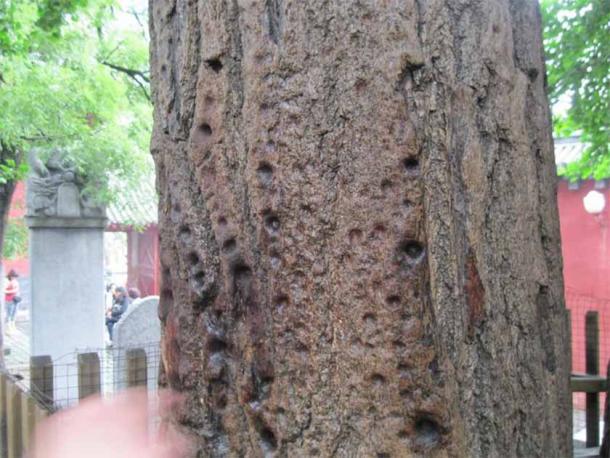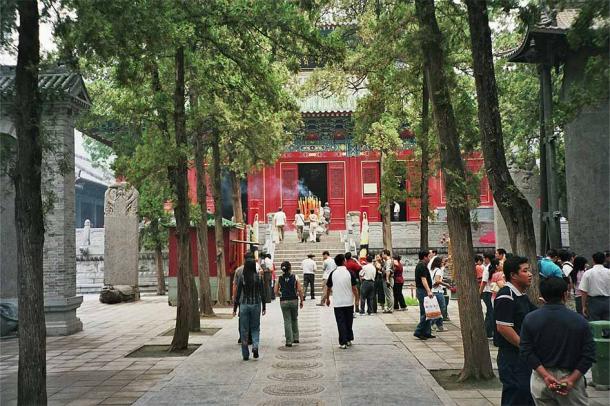
The Historic Struggle of China’s Culturally Rich Shaolin Temple
The still famous and active Shaolin Temple monastery is best known as the birthplace of Shaolin Kung Fu and Chan Buddhism, a traditional Chinese subtype of Mahayana Buddhism. Also called Shaolin Temple, it is located in the high mountains of Henan Province, China, and was first established in 477 AD. Nowadays, the monastery is known as a major tourist attraction in China and has the distinction of being a Global Low-Carbon Ecological Scenic Spot (GLESS).
Shaolin Temple is heavily visited because of its rich and fascinating history. It was built in the Northern Wei Dynasty, but over the centuries the temple encountered several challenging periods before becoming the modern-day tourist attraction it is today. The story starts in the 5th century AD.
Modest Beginnings: The First Shaolin Temple Buildings
As previously stated, the Shaolin Temple was built in 477 AD by Emperor Xiowen of the Northern Wei Dynasty. Batuo, a dhyana master, had come to China to preach Buddhism and was presented with the temple to accommodate his teachings. Because of his widespread work, the Shaolin Monastery became a popular center for Buddhist teachings. It also became involved in translating original Buddhist scriptures into Chinese.
Batuo and his followers continued this work until 527 AD, when the Indian patriarch of Mahayana Buddhism, Bodhidharma, visited the temple. Bodhidharma had been living as a missionary in China for several years before finding the temple and wished to share his own beliefs with Batuo and his disciples. It was through Bodhidharma that Chan Buddhism was introduced to the Shaolin Monastery, which then led to the development of Chinese Chan Buddhism.
- 11 of the Most Ancient and Continually Occupied Cities in the World
- Siddhartha Gautama: How The Father of Buddhism Walked From Suffering to Enlightenment
After this, it is said that teachings within the temple became more intense. Legend says that Huike, Bodhidharma’s disciple, once cut off his arm just to prove his devotion to his beliefs. Soon after this, the temple started facing persecution from those who feared the growing influences of Buddhism. Emperor Wu of the Northern Zhou Dynasty in particular, spearheaded an effort to persecute the Buddhists and Daoists, which drove out some of the disciples of the Shaolin Temple, including Huike.
By 580 AD, Emperor Jing had taken over the Northern Zhou Dynasty and had renamed the temple the Zhi’ao Temple and restored it to its pre-persecution state.
Later written works greatly exaggerate or twist the works of Bodhidharma related to Shaolin Temple, but the basics of his work are still recorded. By 1125, he had a separate, smaller temple built in his honor at the site of Shaolin Temple.

34th generation Shaolin warrior monk Shi Yan Ming, at the Manhattan, New York Shaolin Temple on November 4, 2010. (Luigi Novi / CC BY 3.0)
From Rags to Riches: Shaolin Temple Rising . . .
After Emperor Jing’s restoration, Emperor Wen of the Sui Dynasty gave the temple its old name back. He also gave the temple over 100 hectares (247 acres) of land as a gift in apology for the prior persecution and changes to the temple. The temple was once again restored to its place as the center of Chan Buddhism in China. Visitors that had previously stopped practicing due to persecution once again returned to the temple to resume their Buddhist practices.
Unfortunately, all good things must come to an end. Around 618 AD, just before the end of the Sui Dynasty, misfortune struck the Shaolin Monastery again. Thieves and other intruders began to rob the temple and inflict destruction on it. Several of the monks within the temple had to band together to fight these intruders regularly to protect their place of worship.
After noticing their skills and devotion, the co-founder of the Tang Dynasty Li Shimin used them to help defeat the Sui Dynasty forces. Ultimately, the monks were successful in this mission and were rewarded with additional land and a water mill for the temple. Some legends also claim they were provided an “imperial dispensation” that allowed them to consume alcohol on the temple premises, though this is not confirmed. If it were, Shaolin Temple would have been the only religious temple in China at that time that was permitted to have alcohol on its grounds.
Soon after this win, Shaolin Temple gained even more popularity. Rather than visitations from average worshippers, high officials including emperors began to visit the temple as a special place to rest. In return for their hospitality, the monks often received hefty donations from these officials. The more they let them stay at the temple, the more money and goods they would receive. It was a simple way to get enough funding to keep the temple maintained and the monks well fed.
Throughout the 1st and 2nd centuries, the temple was highly prosperous. Thanks to the many donations from high officials, the temple’s Chan Buddhist School became the largest Buddhist school in the nation. In total, the temple had been gifted over 5,666 hectares (14,000 acres) of land over the years to use however it saw best. By the end of the Song Dynasty, the temple also had over 2,000 monks serving in it and over 5,000 rooms for monks, worshippers, and other visitors to reside in.

The Pagoda Forest at Shaolin Temple an ancient landscape of stone or brick pagodas built from 791 AD during the Tang Dynasty through the Song Dynasty, Yuan Dynasty, Ming Dynasty, and Qing Dynasty. (Wintran / CC BY 2.5)
Restoration in the Face of Opposition
At the beginning of the Yuan Dynasty, Shaolin Temple once again saw itself under construction. Multiple towers were added to the grounds as well as some much-needed renovations. The temple continued to be successful throughout this dynasty until its fall in the 14th century. Around this time, there was significant unrest within the community, and the monks of the Shaolin Monastery yet again had to protect it from destructive intruders.
Unfortunately, the monks of this generation were not as successful this time around. One major uprising against the Yuan dynasty from the Red Turban Rebellion destroyed the temple almost entirely, rendering it unfit for use for several years. The temple was abandoned until sometime around 1359 when Henan was retaken by imperial troops. Rebuilding at this point was difficult, as the temple did not have the money or resources it previously had to restore itself. Those most committed to their place of worship still returned to make the best of the situation.
Eventually, the Ming dynasty government chose to restore the temple after the monks agreed to train their generals in martial arts to help them fight Japanese pirates. The government not only rebuilt the temple and restored its grounds, but it also gave the monks of the temple additional benefits such as tax exemptions on food and other goods. The Ming dynasty was so impressed with the Shaolin monks and their work that they were frequently requested to help defend the dynasty in various wars.
- The Zhou Dynasty: The Longest-Lasting Dynasty in Chinese History
- Adapting Buddhism: Ancient Disciples of Siddhartha Gautama in Afghanistan and Iran
Throughout the rest of the Ming Dynasty, high officials would honor the Shaolin monks by continuing to expand Shaolin Temple through additional monuments and buildings. Shaolin kung fu continued to be taught at the temple, and this work helped to establish Shaolin kung fu as an essential martial arts form. Thanks to the Ming Dynasty, Shaolin Temple found itself at the height of its success, even richer than it was during the Song Dynasty.
Unfortunately, the story doesn’t end there. In the mid-17th century, the Shaolin Monastery was once again ransacked and destroyed. Local rebels did not like the support the temple had for the Ming Dynasty, so they chose to destroy the center of the dynasty’s defense training. While a few monks chose to remain on the grounds, others found it inhospitable and had to find new homes.
In the 18th century, the Qing Dynasty decided to restore the temple yet again. Qing emperors provided many donations to the Shaolin Monastery including a tablet, expensive reconstructions, and a new gate. Many high officials of the Qing Dynasty found Shaolin Temple to be a place of inspiration and would often visit to rest or write poetry there.

A tree within the Shaolin Temple complex used by the warrior monks to practice finger-punching. (ST4991 / Public domain)
Getting Up After Getting Knocked Down
After the Qing Dynasty, the Shaolin Temple complex was peaceful for many years. It continued its work as a place of worship in addition to a place of training. Once the Qing Dynasty was overthrown, the temple faced many hardships. Local wars brought some destruction to the monastery and the monks had to be re-trained for combat. Yunsong Henglin, a monk from the Dengfeng County Monks Association, was chosen to lead the Shaolin Militia, which trained the Shaolin monks to master new combat skills.
These trained monks helped not only defend the temple, but also the surrounding community. Children and their families were allowed to live in peace thanks to the protection provided by the Shaolin Temple monks.
Eventually, Shaolin Temple was again attacked and partially destroyed. Their supported warrior General Fan Zhongxiu was defeated by Shi Yousan, and Yousan’s troops set parts of the temple on fire. Several towers and ancient relics were destroyed, and many monks were killed due to these fires. The rest of the temple was salvaged for those who desired to remain there. The temple and the government at the time promoted their martial arts training to bring more attention to the temple and its importance to Chinese culture.
The Cultural Revolution of the mid-20th century resulted in the Shaolin monks abandoning the temple due to destruction and frequent invasions. After this, the Shaolin Monastery complex was once again restored including many of its ancient relics. Areas of the temple that did not need to be restored were also placed under protection from future destruction.

China’s Shaolin Temple monastery in September 2006. (Don-kun / CC BY-SA 3.0)
Kung Fu For Everyone: Onsite and Online!
In 2010, the Shaolin Temple was chosen as a United Nations Educational, Scientific, and Cultural Organization (UNESCO) World Heritage Site. This provided additional funding for restoration, and also granted international protection to the temple to prevent further destruction from outside sources. Since then, the temple has been labeled as a national scenic spot by the China National Tourism Administration and is visited by countless thousands each year.
- 36 Chambers of Death: The Energy Centers of the Ancient Shaolin Martial Arts
- The Tang Dynasty: The Arts Flourished, Family Ties Broke, and a Concubine Became Empress
The Shaolin Temple is still active right now. It currently offers training in Shaolin kung fu both in-person and online, though in-person admissions are postponed until 2023 due to COVID restrictions. When open in person, they offer several programs including the Shaolin Warrior Program, Master Certification, and Discipleship.
Those not interested in learning Shaolin kung fu themselves can learn more about the practice by watching kung fu shows held regularly at the temple. Those who are eager to learn more now rather than later can start with one of their online courses.
It’s been a long and challenging journey, but thanks to the hard work and commitment of the Shaolin Monastery’s monks, this beautiful temple is still standing. If you ever find yourself in Henan, be sure to check out this incredible, culturally-rich landmark for yourself.
Top image: A modern monk walks into Shaolin Temple, famous for its kung-fu warriors, located in the high mountains of Henan, China. Source: Daniel / Adobe Stock
By Lex Leigh
References
Franklin, J. 2022. Shaolin temple. Available at: https://www.britannica.com/topic/Shaolin-Temple
UNESCO World Heritage Centre. n.d. Historic Monuments of Dengfeng in "The centre of heaven and earth." Available at: https://whc.unesco.org/en/list/1305/
Shaolin Temple Kung Fu Academy. n.d. Learn Kung Fu in China. Available at: https://shaolin-kungfu.net/
Shaolin Temple Yunnan. 2022. Shaolin Temple Yunnan. Available at: https://shaolintemple.com/
Travel China Guide. 2021. Shaolin temple. Available at: https://www.travelchinaguide.com/attraction/henan/luoyang/songshan_shaolin.htm
Visit Our China. n.d. Shaolin temple. Available at: https://www.visitourchina.com/zhengzhou/attraction/shaolin-temple.html
Szczepanski, K. 2019. The Legend of Shaolin Monk Warriors. Available at: https://www.thoughtco.com/history-of-the-shaolin-monks-195814















